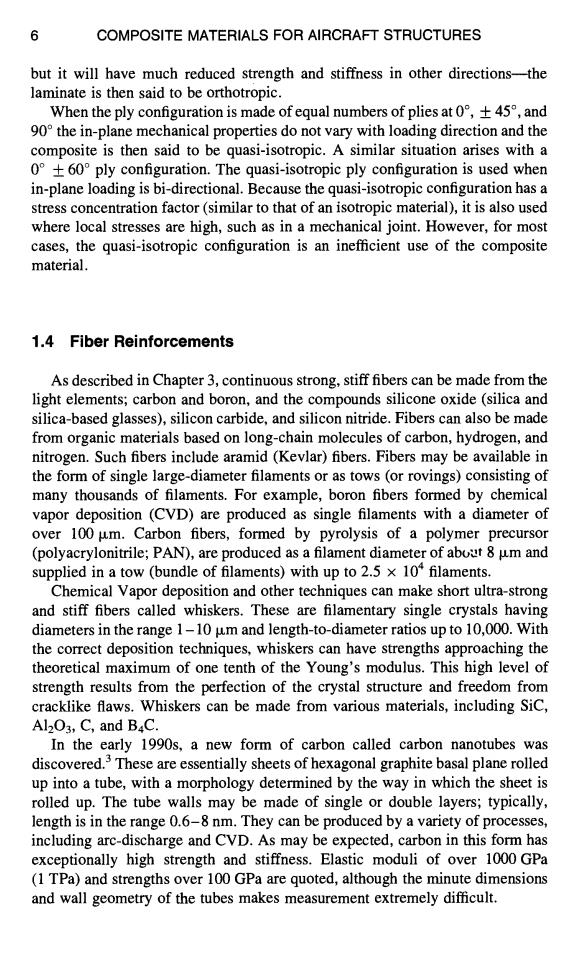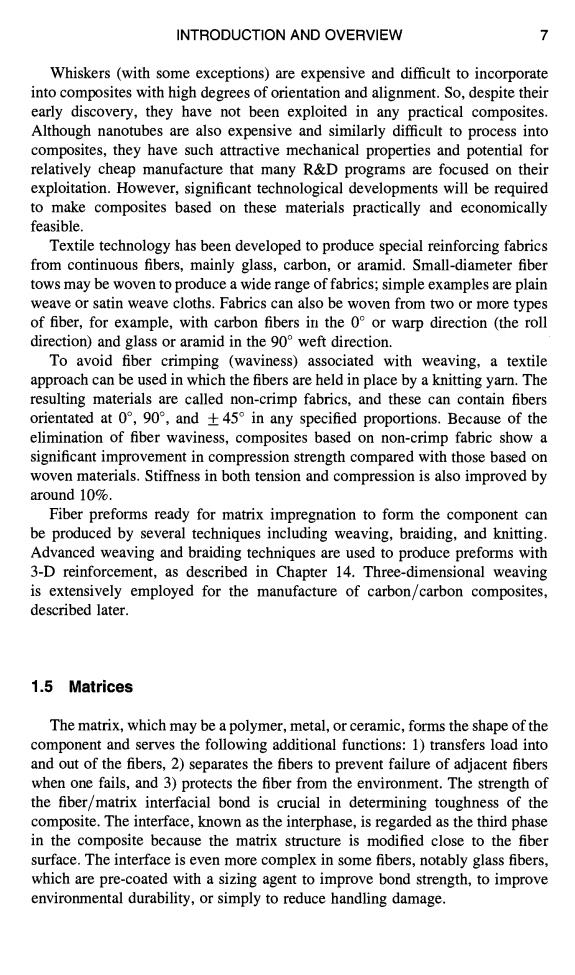
6 COMPOSITE MATERIALS FOR AIRCRAFT STRUCTURES but it will have much reduced strength and stiffness in other directions-the laminate is then said to be orthotropic. When the ply configuration is made of equal numbers of plies at0°,±45°,and 90the in-plane mechanical properties do not vary with loading direction and the composite is then said to be quasi-isotropic.A similar situation arises with a 060 ply configuration.The quasi-isotropic ply configuration is used when in-plane loading is bi-directional.Because the quasi-isotropic configuration has a stress concentration factor(similar to that of an isotropic material),it is also used where local stresses are high,such as in a mechanical joint.However,for most cases,the quasi-isotropic configuration is an inefficient use of the composite material. 1.4 Fiber Reinforcements As described in Chapter 3,continuous strong,stiff fibers can be made from the light elements;carbon and boron,and the compounds silicone oxide(silica and silica-based glasses),silicon carbide,and silicon nitride.Fibers can also be made from organic materials based on long-chain molecules of carbon,hydrogen,and nitrogen.Such fibers include aramid (Kevlar)fibers.Fibers may be available in the form of single large-diameter filaments or as tows (or rovings)consisting of many thousands of filaments.For example,boron fibers formed by chemical vapor deposition (CVD)are produced as single filaments with a diameter of over 100 um.Carbon fibers,formed by pyrolysis of a polymer precursor (polyacrylonitrile;PAN),are produced as a filament diameter of about 8 um and supplied in a tow (bundle of filaments)with up to 2.5 x 10 filaments. Chemical Vapor deposition and other techniques can make short ultra-strong and stiff fibers called whiskers.These are filamentary single crystals having diameters in the range 1-10 um and length-to-diameter ratios up to 10,000.With the correct deposition techniques,whiskers can have strengths approaching the theoretical maximum of one tenth of the Young's modulus.This high level of strength results from the perfection of the crystal structure and freedom from cracklike flaws.Whiskers can be made from various materials,including SiC, Al2O3,C,and B4C. In the early 1990s,a new form of carbon called carbon nanotubes was discovered.These are essentially sheets of hexagonal graphite basal plane rolled up into a tube,with a morphology determined by the way in which the sheet is rolled up.The tube walls may be made of single or double layers;typically, length is in the range 0.6-8 nm.They can be produced by a variety of processes, including arc-discharge and CVD.As may be expected,carbon in this form has exceptionally high strength and stiffness.Elastic moduli of over 1000 GPa (1 TPa)and strengths over 100 GPa are quoted,although the minute dimensions and wall geometry of the tubes makes measurement extremely difficult
6 COMPOSITE MATERIALS FOR AIRCRAFT STRUCTURES but it will have much reduced strength and stiffness in other directions--the laminate is then said to be orthotropic. When the ply configuration is made of equal numbers of plies at 0 °, ___ 45 °, and 90 ° the in-plane mechanical properties do not vary with loading direction and the composite is then said to be quasi-isotropic. A similar situation arises with a 0 ° +__ 60 ° ply configuration. The quasi-isotropic ply configuration is used when in-plane loading is bi-directional. Because the quasi-isotropic configuration has a stress concentration factor (similar to that of an isotropic material), it is also used where local stresses are high, such as in a mechanical joint. However, for most cases, the quasi-isotropic configuration is an inefficient use of the composite material. 1.4 Fiber Reinforcements As described in Chapter 3, continuous strong, stiff fibers can be made from the light elements; carbon and boron, and the compounds silicone oxide (silica and silica-based glasses), silicon carbide, and silicon nitride. Fibers can also be made from organic materials based on long-chain molecules of carbon, hydrogen, and nitrogen. Such fibers include aramid (Kevlar) fibers. Fibers may be available in the form of single large-diameter filaments or as tows (or rovings) consisting of many thousands of filaments. For example, boron fibers formed by chemical vapor deposition (CVD) are produced as single filaments with a diameter of over 100 p~m. Carbon fibers, formed by pyrolysis of a polymer precursor (polyacrylonitrile; PAN), are produced as a filament diameter of about 8 Ixm and supplied in a tow (bundle of filaments) with up to 2.5 x 10 4 filaments. Chemical Vapor deposition and other techniques can make short ultra-strong and stiff fibers called whiskers. These are filamentary single crystals having diameters in the range 1 - 10 Izm and length-to-diameter ratios up to 10,000. With the correct deposition techniques, whiskers can have strengths approaching the theoretical maximum of one tenth of the Young's modulus. This high level of strength results from the perfection of the crystal structure and freedom from cracklike flaws. Whiskers can be made from various materials, including SiC, A1203, C, and B4C. In the early 1990s, a new form of carbon called carbon nanotubes was discovered. 3 These are essentially sheets of hexagonal graphite basal plane rolled up into a tube, with a morphology determined by the way in which the sheet is rolled up. The tube walls may be made of single or double layers; typically, length is in the range 0.6-8 nm. They can be produced by a variety of processes, including arc-discharge and CVD. As may be expected, carbon in this form has exceptionally high strength and stiffness. Elastic moduli of over 1000 GPa (1 TPa) and strengths over 100 GPa are quoted, although the minute dimensions and wall geometry of the tubes makes measurement extremely difficult

INTRODUCTION AND OVERVIEW 7 Whiskers(with some exceptions)are expensive and difficult to incorporate into composites with high degrees of orientation and alignment.So,despite their early discovery,they have not been exploited in any practical composites. Although nanotubes are also expensive and similarly difficult to process into composites,they have such attractive mechanical properties and potential for relatively cheap manufacture that many R&D programs are focused on their exploitation.However,significant technological developments will be required to make composites based on these materials practically and economically feasible. Textile technology has been developed to produce special reinforcing fabrics from continuous fibers,mainly glass,carbon,or aramid.Small-diameter fiber tows may be woven to produce a wide range of fabrics;simple examples are plain weave or satin weave cloths.Fabrics can also be woven from two or more types of fiber,for example,with carbon fibers in the 0 or warp direction (the roll direction)and glass or aramid in the 90 weft direction. To avoid fiber crimping (waviness)associated with weaving,a textile approach can be used in which the fibers are held in place by a knitting yarn.The resulting materials are called non-crimp fabrics,and these can contain fibers orientated at0°,90°,and±45°in any specified proportions..Because of the elimination of fiber waviness,composites based on non-crimp fabric show a significant improvement in compression strength compared with those based on woven materials.Stiffness in both tension and compression is also improved by around 10%. Fiber preforms ready for matrix impregnation to form the component can be produced by several techniques including weaving,braiding,and knitting. Advanced weaving and braiding techniques are used to produce preforms with 3-D reinforcement,as described in Chapter 14.Three-dimensional weaving is extensively employed for the manufacture of carbon/carbon composites, described later. 1.5 Matrices The matrix,which may be a polymer,metal,or ceramic,forms the shape of the component and serves the following additional functions:1)transfers load into and out of the fibers,2)separates the fibers to prevent failure of adjacent fibers when one fails,and 3)protects the fiber from the environment.The strength of the fiber/matrix interfacial bond is crucial in determining toughness of the composite.The interface,known as the interphase,is regarded as the third phase in the composite because the matrix structure is modified close to the fiber surface.The interface is even more complex in some fibers,notably glass fibers, which are pre-coated with a sizing agent to improve bond strength,to improve environmental durability,or simply to reduce handling damage
INTRODUCTION AND OVERVIEW 7 Whiskers (with some exceptions) are expensive and difficult to incorporate into composites with high degrees of orientation and alignment. So, despite their early discovery, they have not been exploited in any practical composites. Although nanotubes are also expensive and similarly difficult to process into composites, they have such attractive mechanical properties and potential for relatively cheap manufacture that many R&D programs are focused on their exploitation. However, significant technological developments will be required to make composites based on these materials practically and economically feasible. Textile technology has been developed to produce special reinforcing fabrics from continuous fibers, mainly glass, carbon, or aramid. Small-diameter fiber tows may be woven to produce a wide range of fabrics; simple examples are plain weave or satin weave cloths. Fabrics can also be woven from two or more types of fiber, for example, with carbon fibers in the 0 ° or warp direction (the roll direction) and glass or aramid in the 90 ° weft direction. To avoid fiber crimping (waviness) associated with weaving, a textile approach can be used in which the fibers are held in place by a knitting yam. The resulting materials are called non-crimp fabrics, and these can contain fibers orientated at 0 °, 90 °, and _ 45 ° in any specified proportions. Because of the elimination of fiber waviness, composites based on non-crimp fabric show a significant improvement in compression strength compared with those based on woven materials. Stiffness in both tension and compression is also improved by around 10%. Fiber preforms ready for matrix impregnation to form the component can be produced by several techniques including weaving, braiding, and knitting. Advanced weaving and braiding techniques are used to produce preforms with 3-D reinforcement, as described in Chapter 14. Three-dimensional weaving is extensively employed for the manufacture of carbon/carbon composites, described later. 1.5 Matrices The matrix, which may be a polymer, metal, or ceramic, forms the shape of the component and serves the following additional functions: 1) transfers load into and out of the fibers, 2) separates the fibers to prevent failure of adjacent fibers when one fails, and 3) protects the fiber from the environment. The strength of the fiber/matrix interfacial bond is crucial in determining toughness of the composite. The interface, known as the interphase, is regarded as the third phase in the composite because the matrix structure is modified close to the fiber surface. The interface is even more complex in some fibers, notably glass fibers, which are pre-coated with a sizing agent to improve bond strength, to improve environmental durability, or simply to reduce handling damage